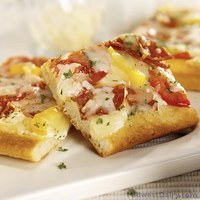Prairie Fare: Say Cheese
(Click an image below to view a high-resolution image that can be downloaded)
By Julie Garden-Robinson, Food and Nutrition Specialist
NDSU Extension Service
“Wow!” was all I could say as my husband served himself a piece of Chicago-style pizza in Chicago recently.
The string of cheese stretched from the platter to over his head until he used the serving utensil to trim it. His arm could not stretch any higher.
Our family finally had returned to Chicago. About 10 years ago, our family of five drove the 600 miles from Fargo to Chicago and tasted the city’s namesake pizza for the first time. Our kids were ages 2, 7 and 10 at the time. Even though we had to wait 45 minutes for the pizza to cook, they were willing to be patient.
As they reminisced about trips through the years, our youngest child complained that we took all the “fun trips” when she was a toddler. She couldn’t remember the amazing pizza. Now 12 years old, she was excited to taste it and make her own memory.
I remember my kids initially thought the pizza had a “weird” appearance. The sauce is placed on top of the cheese inside a deep-dish crust. After tasting the combination of fresh mozzarella, hearty sauce and delicious crust, they were sold on it.
As we drove to Chicago recently, we saw many dairy cows in Wisconsin. The cows produced about 29 billion pounds of milk in 2015. Some of the milk is used to make 3 billion pounds of cheese. Therefore, cheese shops beckoned us off the interstate.
Fresh, squeaky cheese curds are quite tasty, especially if they are flavored with dill and garlic, in my opinion, anyway.
Worldwide, about 2,000 types of cheese are made. About 300 different types of cheese are available in the U.S., according to the National Dairy Council. Dairy producers are located throughout the U.S., so get to know a dairy farmer near you to learn more.
Making cheese is a way to preserve milk. According to legend, cheese was made accidentally when a traveler placed milk in a bladder made of an animal’s stomach as a kind of makeshift canteen. The stomach contained an enzyme called rennet, which caused the milk to form protein-rich curds.
Most types of cheese are composed of just a few ingredients. Besides rennet and milk, salt and a culture of “good bacteria” usually are used. Making a pound of cheese requires 10 pounds of milk.
You can make fresh mozzarella or ricotta cheese at home quite easily. See http://www.nationaldairycouncil.org for the method to make homemade ricotta.
Cheese contributes protein, calcium and phosphorus to our diet, and these nutrients nourish our bones and teeth. Some recently published research has shown no link between heart disease risk and cheese consumption. More research is under way.
Further, some people with lactose intolerance (inability to digest milk sugar) can consume natural cheese without digestive upset.
Keep in mind the calorie content of all your food choices, though. One ounce of cheese has about 100 calories, depending on the type of cheese. An ounce is a 1-inch cube or four small dice. If you are watching your sodium intake, pay attention to Nutrition Facts labels.
If you decide to have a snack of cheese and crackers, place a serving on a plate and put the rest of the food back in the refrigerator or cupboard. Enjoy some fruit and veggies with your cheese for a nutrient-rich snack.
Serving cheese with food may improve choices. Some researchers have shown that sprinkling a little cheese on veggies enticed children to eat them.
Now I am hungry for some cheesy pizza. Try this easy-to-make recipe from the Midwest Dairy Association. It’s not quite Chicago-style pizza, but it tastes great and you don’t have to drive a long way to get it. You could be eating before a pizza delivery person could get to your door. Personalize it by adding some chopped vegetables, such as onions or fresh basil.
Cheese Lovers Pizza Squares
1 can refrigerated pizza dough
1 c. ricotta cheese
2 c. (8 ounces) shredded low-moisture, part-skim mozzarella cheese
2 ounces turkey pepperoni, diced
2 plum tomatoes, thinly sliced
1 c. yellow pepper, sliced
1 tsp. oregano
2 Tbsp. chopped parsley
Preheat oven to 400 F. Press pizza dough into a 15- by 10-inch jelly roll pan. Bake for 12 minutes; remove from oven and spread ricotta cheese over the crust. Top with mozzarella, pepperoni, tomatoes, pepper and oregano. Return to oven and bake for six minutes or until cheese is melted. Sprinkle with parsley, cut into squares and serve.
Makes 10 servings. Each serving has 140 calories, 7 grams (g) fat, 7 g protein, 13 g carbohydrate, 2 g fiber and 330 milligrams sodium.
(Julie Garden-Robinson, Ph.D., R.D., L.R.D., is a North Dakota State University Extension Service food and nutrition specialist and professor in the Department of Health, Nutrition and Exercise Sciences.)
NDSU Agriculture Communication - June 23, 2016
| Source: | Julie Garden-Robinson, 701-231-7187, julie.garden-robinson@ndsu.edu |
|---|---|
| Editor: | Ellen Crawford, 701-231-5391, ellen.crawford@ndsu.edu |



